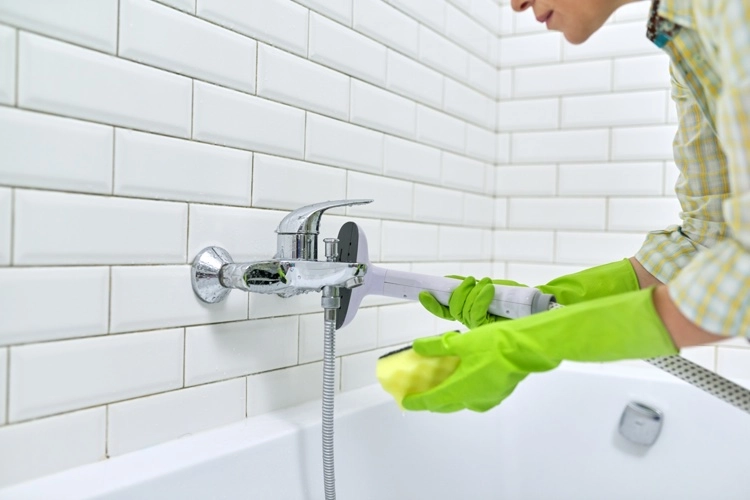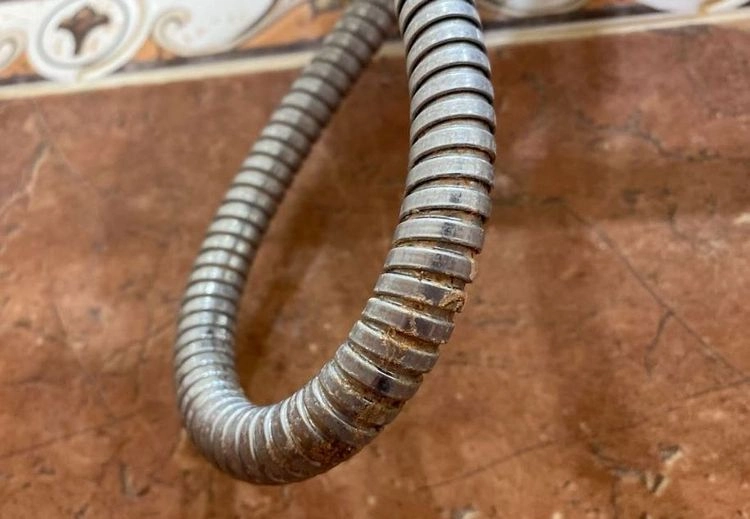Your new bathroom is your dream come true, which you have designed with great care and attention to detail. It’s only been a few weeks since you finished your renovation and there’s still no sign of the shiny fittings? We have a suspect – limescale has most likely moved into your beautiful bathroom. And while it can be quickly spotted and removed in visible places like the faucet or the shower head, some parts of the bathroom fittings often remain neglected because they don’t really catch the eye. So you can often forget to clean the shower hose, which leads to worse deposits over time. In the article we explain how you can easily clean and descale it again.
Why does limescale form so quickly?
Limescale is essentially a thick deposit that forms on surfaces where hard water has evaporated, making showers, faucets, bathtubs and sinks unsightly. Shower hoses that connect the shower system to the showerhead can also be severely affected by limescale build-up. This is especially true in hard water areas. In principle, the harder the water, the faster limescale forms.
The hard or calcareous water can cause the shower hose to become calcified both on the outside and on the inside. Over time, mineral buildup, soap scum, and mold can actually clog the hose. If you’re not careful, this debris can build up and cause your shower hose to stop working and require premature replacement.
Luckily, there are some simple tips and tricks for getting rid of limescale in shower hoses that we’re going to share with you today. Homeowners may already have one of these in their kitchen cupboard.
Clever trick: Clean and decalcify the shower hose with vinegar

Although there are a variety of lime-dissolving cleaning products, many people are turning to using natural substances in their household. If you prefer not to use chemical cleaners, you can also use home remedies to remove limescale from calcified fittings in the bathroom. Some of these are even more effective than expensive cleaners and can help with many other household chores.
One of the best home remedies is good old household vinegar. It is a versatile helper for various cleaning jobs and is considered a proven limescale remover.
And this is how you can clean the shower hose with vinegar:
If possible, remove the hose and place it in the sink (sealed) or in a bucket. Add hot water and vinegar in a 3 to 1 ratio and let the shower hose soak. This may take some time (from an hour to overnight) or you may have to repeat the process several times to remove harder deposits. Finally, rinse the hose with clear water and dry it with a cloth. This method not only removes limescale but also bad odors from inside the hose.
Other home remedies that help against limescale

In addition to vinegar or vinegar essence, there are some home remedies that can be used to prevent limescale deposits in the bathroom. The best of these are citric acid and baking soda, which also work well in combination with the vinegar. You can also use denture cleaners. This is known for the fact that it can not only bring teeth into top shape, but also many other things in the household, such as kettles, drinking bottles – and calcified shower hoses. One should simply dissolve the tablet in some water and then insert the tube into it. After a few hours of exposure, rinse off the hose and screw it back on. This method is perfect for regular descaling of the shower hose – both inside and outside.
Can the hose be cleaned without removing it?

The steam cleaner offers a good way of gently cleaning the outside of the shower hose if you cannot unscrew it. The hot water vapor works well on calcifications that aren’t as stubborn. It also disinfects the surfaces so that all bacteria and germs in the shower are killed. All you should do is spray the fitting and hose with the steam cleaner and then wipe with a microfiber cloth.
If you can’t or don’t want to remove the hose, you can also use the paper towel trick. It’s really simple and works quite well to loosen the buildup and make it easier to remove afterwards. You must do the following:
- Soak a cleaning rag or a few paper towels in household vinegar. Wrap it around the shower hose so that all calcified parts are completely covered.
- Leave the soaked wipes on for 3-4 hours to overnight, wetting again if necessary.
- Remove the kitchen paper and gently wipe away the loosened deposits with a sponge.
Please note: This method only cleans the outside of the shower hose. If your shower isn’t working well, stinks, or has low water pressure, then the inside needs cleaning too.
When do I have to change the shower hose?
If a calcified hose has not been cleaned for a long time, it can show signs of damage. If the shower hose has not been changed for years and it has become porous and leaky as a result, then cleaning is no longer the solution – you need to replace it. Sometimes the limescale deposits inside the hose are so large that the water can’t flow as well and the shower doesn’t work as well. If so, it’s time for a change.
